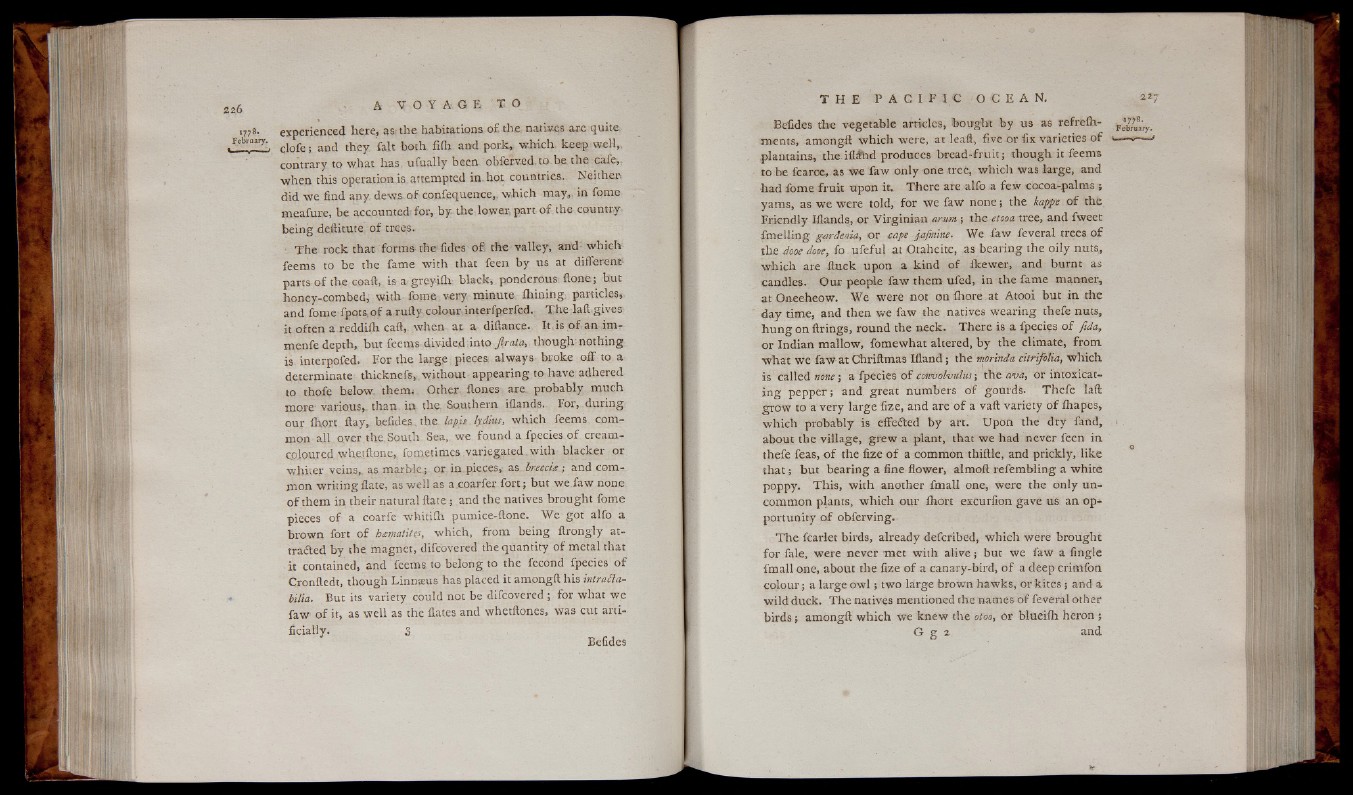
226 A V O Y A G E -T O
1778. experienced here, as the habitations of, the natives are quite
J eb.r-ual7'. qio fe ; and they fait both fifh and pork, which, keep well,,
contrary to what lias u fu a lly been obferved, to be. the cafe,
w hen this operadon.is attempted in. hot countries. Neither
did w e find any, dews o f confequence,. w hich may,, in fome
meafure, be accounted; for, by. the lower, part of. the country
being deftitute o f trees.
T he rock that forms the fides of; the valley, and- w hich
feems to be the fame w ith that feen b y us at different1
parts o f the coaft, is a greyifh. black, ponderous itone;; but
honey-combed; with fome, very, minute ihining. particles,
and fome fp o tso f a rufty co lou r interfperfed. T h e laft gives
it often a.reddifh caft, when at a diftance. It, is of. an im-
xnenfe depth, but fe ems divided into .first», th o u g h nothing
is interpofed. Eor the large pieces a lways broke off to a
determinate thicknefs, , without appearing to have adhered
to thofe below, them- Other itones are probably much
more various,, than in th e Southern illands. For, during
our fhort flay, befides,. the. lapis Ijidius, w hich feems common
all over the. South Sea, w e found a fpecies o f cream-
coloured ,whe.tfton.e, fometirnes variegated.with blacker or
whiter veins,, as marble; or in pieces, as breccia, and common
w riting flate, as well as a.coarfer fort; but we faw none
o f them in their natural flate ; and the natives brought fome
pieces o f a coarfe whitiih pumice-flone. We got alfo a
brown fort o f b&rfiatites, which, from being ftrongly at-
tradled by the magnet, difcovered the quantity o f metal that
it contained, and feems to belong to the fecond fpecies o f
Croniledt, though Linnaeus has placed it amongft his mtraila-
bilia. But its variety could not be difcovered ; for what we
faw o f it, as well as the Hates and whetltones, was cut artificially.
3
Befides
T H E P A C I F I C O C E A N .
Befides the vegetable articles, b ou ght b y us as refrefli- T'etfmry.
rncnts, amongft w h ich were, arlea.fi, five or fix varieties o f <-— 0— <
plantains, the ifltfhd produces bread-fruit; though it feems
to be fcarce, as w e faw only one tree, w hich was large, and
had fome frn it upon it. There aTe alfo a few cocoa-palms ;
yams, as w e were told, fo r w e faw n o n e ; the kappe o f the
Friendly Iflands, or V irg inian arum ; the etooa tree, and fweet
fm e llin g gardenia, o r cape jj,afm'me. We faw feveral trees o f
the dope done, fo u fe fu l at Otaheite, as bearing the o ily nuts,
w hich are ftuck upon a kin d o f fkewer, and burnt as
candles. Our people faw them ufed, in the fame manner,
at Gneeheow. We were not o n fh o r e .a t Atooi but in the
d a y time, and then we faw the natives w ea rin g thefe nuts,
h u n g on firings, round the neck. There is a fpecies o f fida,
o r Indian mallow, fomewhat altered, b y the climate, from
w h a t we faw at Chriftmas Ifland; the morinda citrifilia, which
is called none 5 a fpecies o f convolvulus; the ava, or intoxicatin
g pepper; and great numbers o f gourds. T he fe laft
grow to a very large fize, and are o f a vaft variety o f fhapes,
w hich probably is effected by art. Upon the dry fand,
about the villa ge , grew a plant, that we had never feen in
thefe feas, o f the fize o f a common thiftle, and prickly, like
th a t ; but bearing a fine flower, almoft refembling a white
poppy. T his , w ith another fmall one, were the only uncommon
plants, which our fhort excurfion gave us an opportunity
o f obferving.
T h e fcarlet birds, already defcribed, w hich were brought
fo r fale, were never m e t with a liv e ; but we faw a Angle
fmall one, about the fize o f a canary-bird, o f a deep critnfon
colour; a large o w l ; two large brown hawks, or kites ; and a
w ild duck. The natives mentioned the names o f feveral other
b ird s ; amongft w hich we kn ew the otoo, or blueiih heron ;
G g 2 and